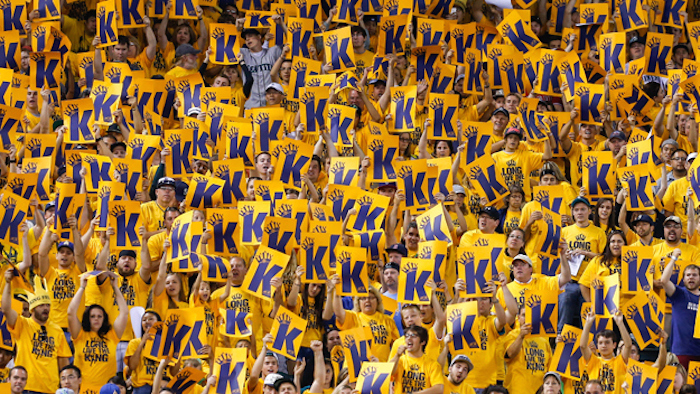In the alphabetic hierarchy A gets all the attention and Z comes in last, but the most symbolically crafty of all the letters is K. Although sometimes known as soft and silent, when hard it is the strongest of the twenty-six, not just in English but in German too. The look, sound and weight of K are so keenly experienced yet often overlooked, its time to pronounce this K-day and kindle a kind of celebration for the kingpin of stand alone letters.
There are so many ways people have capitalized on K:
Henry Chadwick, creator of the venerable baseball box score, chose K to symbolize a strikeout because it was the last letter in “struck” as in “struck out.” It has stuck like tar for over a hundred years.
In Franz Kalfka’s The Trial Josef K is arrested by two unidentified agents from an unspecified agency for an unspecified crime. The agents’ boss later conducts a mini-tribunal in the room of K’s neighbor, Fräulein Bürstner. K is not taken away, however, but left free and told to await instructions from the Committee of Affairs.
K-rations were invented by Dr. Ancel Keys (from which the K derives) in 1941. The government assigned him to design a non-perishable, ready-to-eat meal that could fit in a soldier’s pocket as a short-duration, individual ration. Keys choose supermarket foods that would be inexpensive and provide energy. “The meals only gained ‘palatable’ and ‘better than nothing’ ratings from the soldiers, but were successful in relieving hunger and providing sufficient energy.”
Special K, the rice and wheat cereal, was introduced in 1955 four years after Kellogg Company’s founder, W. K. Kellogg, died at the age of ninety-one. His body lay in state for three days in the main lobby of the company office building so that hundreds of workers and Battle Creek residents could pay their respects—now that was special.
K2 is the world’s second highest peak (28,251 feet) second only to Everest; it is located in the Karakoram Range in a Chinese-administered part of Kashmir within the Uygur Autonomous Region of Xinjiang, China.
K4s are very small, yellow, easily crushed pills that contain 4 milligrams of hydromorphone under the brand name Dilaudid. They contain no harmful filler ingredients and are safe to inject directly into the veins. Kicks are getting harder to find.
K9 is the military designation for a dog, the transliteration of the word canine.
K in science literature is an abbreviation of kalium, the Latin name for potassium.
K is a unit of measure for temperature based upon an absolute scale.
K is short for kilo.
K is used to refer to numbers or distance in thousands, 1k = 1000.
K signifies the color black of K for key—a shorthand for the printing term key plate, printing in black ink as in CYMK.
K-particle or kaon, also called a K meson, and shortened to K has something to do with quarks (or quacks).
K for kindergarten was a term coined by Friedrich Fröbel, a visionary German educator, whose approach influenced early-years education. The raging issue today is equal pre-K opportunities.
K in German, as in the spelling of America as Amerika (and the title of another Kafka novel) has been used to compare the US to European dictatorships.
K is also shorthand for OK, which is given many origins, among them as an abbreviation of “orl korrekt,” a jokey misspelling of “all correct” which was current in the US in the 1830s.
KKK is among the most hateful of the many usages—Kooks, Killers, Klan—and not necessary to celebrate here.
If you have more K usages, applications, abbreviations, words, or stories, send them to us … K?










 Steven Heller is the co-chair (with Lita Talarico) of the School of Visual Arts MFA Design / Designer as Author + Entrepreneur program and the SVA Masters Workshop in Rome. He writes the Visuals column for the New York Times Book Review,
Steven Heller is the co-chair (with Lita Talarico) of the School of Visual Arts MFA Design / Designer as Author + Entrepreneur program and the SVA Masters Workshop in Rome. He writes the Visuals column for the New York Times Book Review,